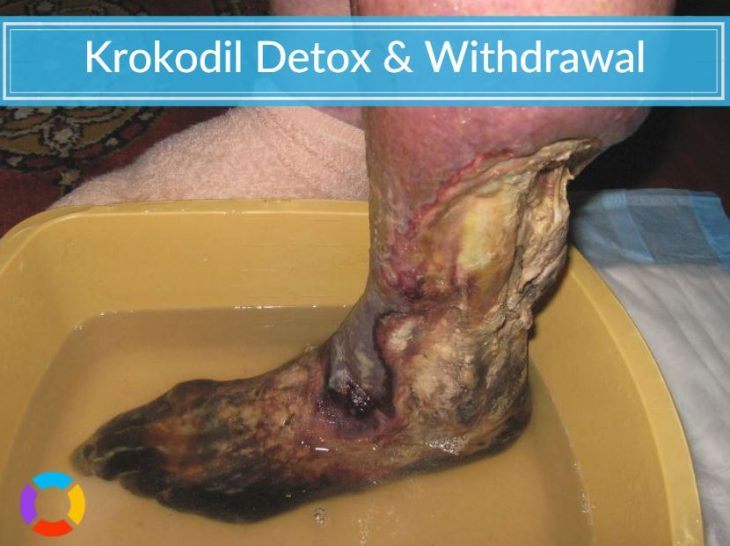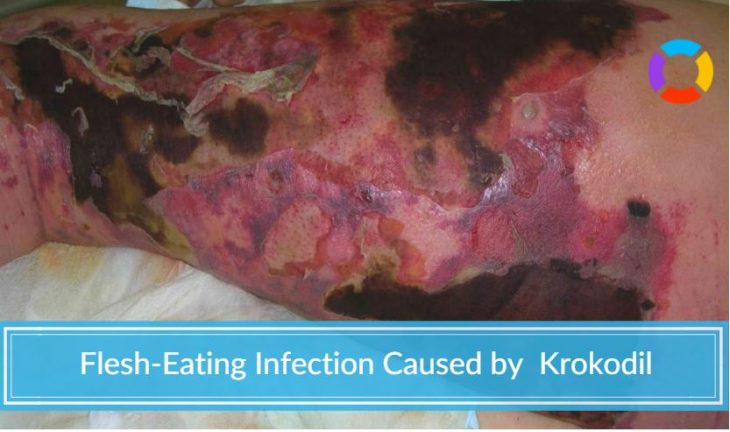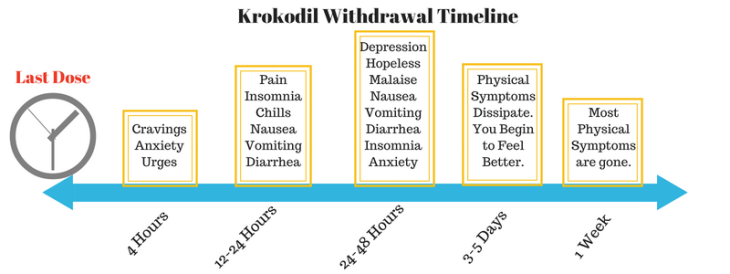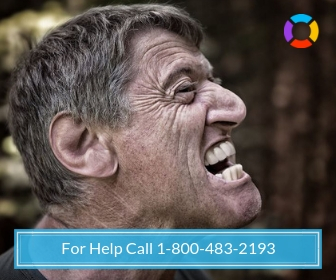Krokodil Detox
Signs, Symptoms and Treatment for Krokodil Addiction & Withdrawal
Krokodil is the street name for an opiate analog called desomorphine. Touted as being 10X more potent than morphine and equally lethal, Krokodil gains its name as a result of the toxic effects that this drug has on a user’s body. Dark, scaly, green infections are common in chronic Krokodil users–an image similar to a crocodile.
 This flesh-eating drug was widely abused throughout Russia for many ten years but only recently made its debut in America in 2013. Ohio, Arkansas, and Illinois are among some of the first states to document the use of this dangerous opiate. Also called a “zombie drug,” Krokodil essentially eats human flesh from the inside out.
This flesh-eating drug was widely abused throughout Russia for many ten years but only recently made its debut in America in 2013. Ohio, Arkansas, and Illinois are among some of the first states to document the use of this dangerous opiate. Also called a “zombie drug,” Krokodil essentially eats human flesh from the inside out.
You may ask, “WHY would someone want to use a drug that will create an immediate addiction that is certain to end in death?” You’re not alone! According to NIDA, “many people don’t understand why or how other people become addicted to drugs.” Unfortunately, drugs change the way the brain works making quitting even more difficult for those who abuse them.
The fact is, people don’t generally say “I want to be an addict.” But, they use drugs not realizing the potential for addiction to occur. They think “It won’t happen to me.” But it does. And once addicted, quitting becomes a challenging effort that requires medical attention, support from friends, family, and peers, and a STRONG will to survive.
Unfortunately, First Coast News mentions that extreme risk of Krokodil being like NO-OTHER opiate. Users are almost certain to become addicted due to the mere power and potency of the drug and they have a 1-2 year life expectancy following their first dose. No other drug at this time has such a rapid rate of creating dependence and subsequent death.
History of Krokodil
Desomorphine originates in Switzerland where it was synthesized for pain relief in the 1930s. In the US, Krokodil became a controlled substance in 1936. It continued to be used in Switzerland for about 20 years before researchers realized the strong potential for Krokodil use to lead to addiction. As a result, Krokodil was removed from medical use in 1952 and has since been labeled a Schedule 1 substance by the DEA and has NO ACCEPTED MEDICAL USE.
Krokodil ran under the radar for the next 60 years. Recent rises in opiate abuse have caused this powerful synthetic opioid to make a rapid comeback. Russia has reported increased use of the drug since 2002. In the US, desomorphine abuse was initially spotted in Arizona but has since spread throughout the country.
How is Krokodil Made?
 Desomorphine (4,5-a-epoxy-17-methylmorphinan-3-ol) has a similar chemical structure to morphine but is much more powerful. The active ingredient in the street version of Krokodil is Codeine. Codeine is a mild opiate that is commonly sold over-the-counter in many countries outside the United States.
Desomorphine (4,5-a-epoxy-17-methylmorphinan-3-ol) has a similar chemical structure to morphine but is much more powerful. The active ingredient in the street version of Krokodil is Codeine. Codeine is a mild opiate that is commonly sold over-the-counter in many countries outside the United States.
Codeine, alone, is not too dangerous except in high doses. But when it is mixed with other dangerous substances and ingredients such as paint thinner and hydrochloric acid it becomes lethal. Krokodil is a mixture of these substances as well as red phosphorus which can be found in the strike pad of a matchbox according to Time Magazine.
When these ingredients are mixed together they create a horrible smelling liquid that produces powerful effects similar to heroin at a fraction of the cost. Users report Krokodil costing about 1/5th or less than heroin but equally or more potent.
Sadly, addicts pay the ultimate price for a cheap high. Harmful effects of Krokodil lead to serious physical consequences including limb loss, disease, and ultimately death. Average life expectancy for a user addicted to desomorphine is very short–often less than twelve months.
Effects of Desomorphine Abuse
The most notable effects of Krokodil abuse are seen on the skin. Users appear to be rotting from the inside out. Short-term effects of Krokodil use appear much like those of any other opiate abuse. Shallow breathing, pinpoint pupils and euphoria are common. Chronic use leads to:
- Rapid increase in tolerance
- Physical dependence
- Addiction
- Damaged soft tissue
- Damaged organs
- Skin damage
- Broken blood vessels
- Infections
- Green, scaly skin
- Crocodile skin
- Neurological damage
- Death
Krokodil Kills
Abusing this powerful drug has its own set of serious dangers separate from those that are evident with most opiates. Repeat use most certainly leads to death within 12-24 months of the initial use. This is because chronic Krokodil abuse causes widespread, flesh-eating infections that often result in the need to amputate. Eventually there is nothing left to amputate and the user dies as a result of his or her substance abuse.

Like other opiates, repeat use of Krokodil can lead to a heightened risk of HIV, AIDS, Hepatitis C and other disease that can be contracted through shared needles. Addiction develops quickly with this opiate and the decision to quit is not enough to get sober on your own–if you or someone you love has abused Krokodil or other opiates, call our helpline at 800-996-6135 to find a local detox center that will help you get sober in a safe, pain-free medical facility.
Krokodil Withdrawal Symptoms
Physical dependence develops rapidly when abusing Krokodil. In fact, users report an almost immediate addiction to the drug due to the powerful nature. Most users are already addicted to an opiate such as prescription painkillers or heroin prior to using Krokodil. Regardless, once addicted to Krokodil the process of getting sober requires a walk through withdrawal first.
Krokodil withdrawal symptoms include:
- Pain
- Nausea
- Vomiting
- Diarrhea
- Anxiety
- Depression
- Restlessness
- Runny nose
- Fatigue
- Goosebumps
- Bone pain
- Joint pain
- Insomnia
- Sweating
Krokodil Withdrawal Timeline
Opiate withdrawal is a well-documented process that generally follows a relatively predictable timeline. Upon immediate discontinuation of Krokodil or any opiate, the user will notice symptoms of withdrawal within the first 6-24 hours. The amount of time it takes for symptoms to appear depends on the half-life of the drug (the amount of time it takes for half of the drug to be eliminated from the system.)
The half-life of Krokodil is 1-hour. As such, repeat use is highly common because users begin to feel the effects of withdrawal within just 1 hour of the dose. After 4 hours following the last dose, heightened withdrawal symptoms are in full swing.

While the rate at which withdrawal begins for Krokodil users is much faster than for those who use morphine (which has a significantly longer half-life and therefore generally does not produce withdrawal symptoms for up to 12 hours following the last dose), once symptoms of withdrawal begin, the timeline is mostly the same as any other opiate. It appears something like this:
- 1-4 hours after last dose – withdrawal symptoms begin with cravings and a desire to use the drug set in. Anxiety over the ability to “score” another dose heightens during this time.
- 12-24 hours after last dose – searing pain throughout the body, insomnia, and chills set in. Upset stomach may also be present during this time as anxiety spikes. The pupils dilate and restlessness makes it difficult to focus.
- 24-48 hours after last dose – depression, hopelessness and a general feeling of malaise set in. Nausea and vomiting as well as diarrhea are all present. It’s hard to eat or sleep and the time passes VERY slowly.
- 3-5 days after last dose – by the third day all physical symptoms of withdrawal should spike and begin to dissipate. The amount of time it takes for these symptoms to dissipate back to a level of average comfort varies from 1-3 days in most cases.
- 1 week after last dose – most physical symptoms should be resolved at this time and you should begin to feel like yourself. Psychological symptoms such as depression or anxiety may persist for up to 1 month or more.
Krokodil Detox

Opioid withdrawal can be very painful, but it doesn’t have to hurt. Many treatment options are available to ease symptoms of withdrawal so that you can focus on recovery and healing. While you MUST pass through the period of withdrawal in order to recover, you do not have to pass through without help.
Krokodil detox will help to stabilize you in preparation for recovery in a rehab center. Although opiate withdrawal is generally non-life-threatening, it can be highly uncomfortable and potential dangers may arise unexpectedly. Some of the potential risks of detox, which are best treated in an inpatient detox center, include:
- Dehydration – nausea which leads to vomiting and diarrhea can quickly result in dehydration if you’re not careful. Opiate withdrawal that goes untreated for more than 24 hours may cause serious electrolyte imbalances that can disturb the way the heart functions and may cause damage to other vital organs. Medical detox centers can provide intravenous fluids for severe cases where fluids cannot be kept down orally. Additionally, medications such as Ondansetron for opiate withdrawal can reduce nausea and stop vomiting. This medication, as well as others, can be provided under the supervision of a doctor or detox specialist.
- Aspiration – another side effect of vomiting, aspiration occurs when you accidentally inhale stomach contents and bile. This can cause serious lung infections and may even lead to death if you happen to vomit and inhale the vomit in your sleep. 24-hour monitoring in a medical detox center ensures your safety during the most difficult hours of withdrawal when your risk of getting sick is highest. Further, medications can prevent vomiting altogether–you don’t have to feel horrible during withdrawal!
- Relapse and Overdose – relapse rates are highest immediately following withdrawal. In fact, most users relapse within the first 48 hours of their last dose of an opioid. If you get the help of an inpatient detox center, your risk of immediate relapse is reduced substantially. Further, overdose risks following withdrawal are high because you have lost your tolerance to a drug within just a few days of not using. If you think you can quit using for a few days or a week, and then immediately return to your previous level of substance use, you WILL likely overdose.
Safe, medical detox centers are available to help you stabilize and break free from Krokodil addiction. You don’t have to feel horrible during withdrawal, that’s a myth. In fact, detox professionals can help you to feel at ease and even comfortable during these early days of recovery–but you have to call for help. Our helpline is available 24 hours a day, 7 days a week to support you. Call 800-996-6135 .
Medications for Krokodil Addiction Treatment
While there are no medications that “treat” addiction and cure it, there are many medications that can be used to curb the cravings and other side effects that come during opiate withdrawal. Talk with your healthcare provider or a detox specialist about the following maintenance medications that may be used to help you remain sober long term:
- Buprenorphine – this medication works much like methadone but has a much lower potential to cause addiction.
- Naltrexone – this medication stops cravings and prevents the user from wanting to take opiates.
- Methadone – this is an opiate that is used to suppress cravings and minimize symptoms of withdrawal.
- Suboxone – this is the brand name for the generic drug Buprenorphine.
- Subutex – this is the brand name for a combined drug that includes both naltrexone and buprenorphine.
Each of these medications increases the retention rate and overall effectiveness of detox and rehabilitation treatment efforts. If you’ve been abusing Krokodil or other opiates long-term, a maintenance medication that treats addiction beyond the withdrawal period can help you to stay sober. According to the Journal of Addictive Diseases, “methadone, buprenorphine, and naltrexone are each FDA approved for the long-term treatment of opiate addiction.”
Additionally, some medications can be utilized during the withdrawal period to ease symptoms that are uncomfortable or otherwise unwanted. The following medications may be provided to you during Krokodil detox:
- Benzodiazepines such as valium or xanax. Each of these can reduce anxiety and irritability. They may also help to promote sleep.
- Antidepressants such as Zoloft or Prozac may reduce depression and induce pain relief during opiate withdrawal. These medications generally need to be taken for a few weeks before the full effects are felt.
- Clonodine is a medication often used in the treatment of both alcohol withdrawal and opiate withdrawal, reduces the sweating and muscle aches that arise during the first few days of Krokodil withdrawal. This medication can also reduce stomach cramps.
- Over-the-counter medications including ibuprofen, acetaminophen, immodium AD and other supplements can be used sparingly to treat aches and pains, upset stomach, diarrhea and other symptoms of opiate withdrawal.
Get Help Today
Some try to detox at home or without supervised help, but it’s important to accept and admit that you cannot do it alone. Opiate withdrawal is a painful process that generally leads to failure for those who try to get sober without professional help. However, medical detox can make an uncomfortable process much easier and safer too.
Call our helpline toll-free at 800-996-6135 for help getting sober. We realize it’s scary and that you probably fear what will happen when you call, but this call could literally save your life.
Sources
- National Institute on Drug Abuse. (2018). Understanding Drug Use and Addiction.
- First Coast News. (2016). Deadly, Flesh-Eating Drug Krokodil Appears on First Coast.
- Drug Enforcement Administration. (2013). Desomorphine (Dihydrodesoxymorphine; dihydrodesoxymorphine-D; Street Name: Krokodil, Crocodil).
- Time Magazine. (2013). The World’s Deadliest Drug: Inside a Krokodil Cookhouse.
- Journal of Addictive Diseases. (2012). Maintenance Medication for Opiate Addiction: The Foundation of Recovery.

